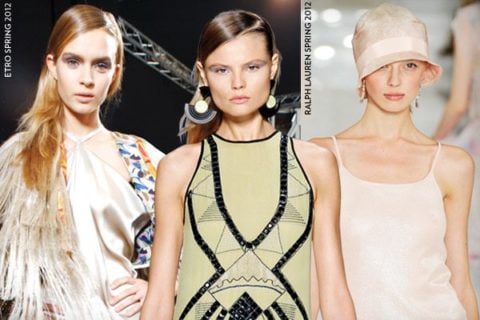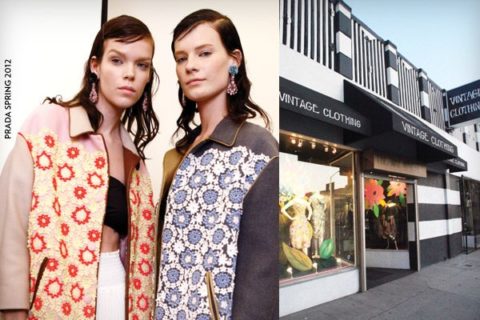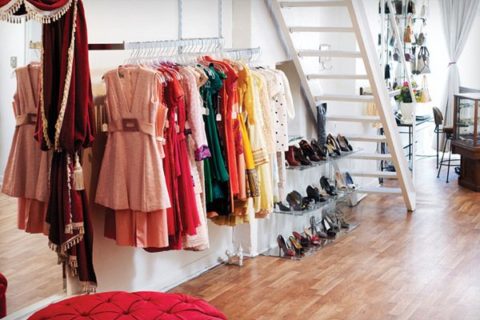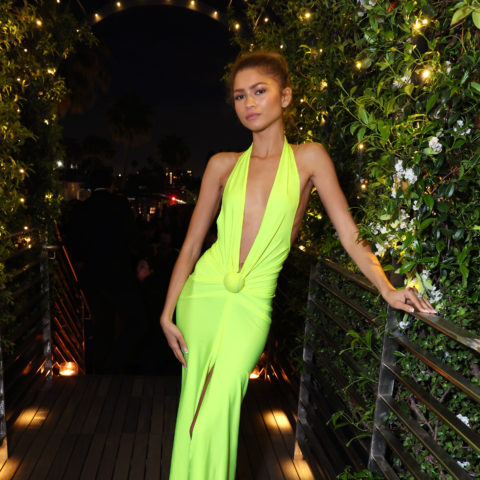Look again: Vintage fashion continues to influence runways and red carpets. We narrow down the most iconic pieces to invest in today


See our vintage-inspired slideshow »
By Samantha Shephard
It’s a sunny Saturday morning in West Hollywood and Rita Ryack, the Oscar-nominated costume designer known for her work on Casino and A Beautiful Mind, is on a hunt for sequined dresses. Production on the film Rock of Ages is wrapping and she needs one more piece for Catherine Zeta-Jones’ character. Judging by the racks she’s browsing, which are filled with this season’s hottest labels and trends—Versace print T-shirts, heavily embellished Moschino jackets, sweeping red carpet–worthy gowns—you’d think she were shopping at an upscale department store. Think again. She’s at The Way We Wore, a vintage-clothing mecca that attracts A-list clients like Angelina Jolie, Dita Von Teese and Katy Perry. The shop is full of high-end designer pieces, like little black dresses from Chanel, elegant Christian Dior gowns, Pauline Trigère party dresses and Pucci pyjama pants, all dating from the 1930s to the early 1990s.
“Vintage is not fashion backwards, it’s fashion forward,” says Doris Raymond, owner of The Way We Wore. She describes the way designers have taken silhouettes from the early 20th century and tweaked them, as John Galliano and Alberta Ferretti have done with their signature bias-cut chiffon dresses. “It doesn’t matter that it’s almost identical in pattern, in silhouette, because it transcends time.”
Looking at this season’s collections, it’s hard to disagree with her. From New York to Paris, designers have reimagined some of fashion’s greatest hits from yesteryear. Luxury houses like Gucci, Etro and Ralph Lauren have zeroed in on the heady decadence of the Jazz Age with embellished flapper dresses, art deco–inspired decoration, drop waists and soft, sheer fabrics. Miuccia Prada showed pencil-skirted pin-ups; Marc Jacobs’ pretty pastels at Louis Vuitton were the picture of Kennedy-era optimism; and Karl Lagerfeld reinterpreted the jetset glamour of the Pan Am era for Chanel haute couture. Though current runway trends and television shows like Pan Am and Mad Men create an awareness of (and a fashion following for) these retro-inspired styles, it is Tinseltown’s red carpets that have given us a VIP pass into the world of high-end vintage dressing. A-listers like Julia Roberts, Penélope Cruz and Reese Witherspoon accepted their Oscars wearing vintage Valentino, Balmain and Dior, respectively. In our celebrity-driven culture, these leading ladies have done more to spur vintage sales than Betty Draper ever could. In Los Angeles, boutiques like The Way We Wore, Decades and The Paper Bag Princess vie to dress the brightest stars, who have learned to value vintage for its old-Hollywood glamour and the guarantee of a one-of-a-kind gown.

It’s not surprising, then, that the most sought-after celebrity stylists tend to be vintage vixens in their own right. Back at The Way We Wore, Arianne Phillips is trying on a dress. A costume designer and stylist who has worked with Madonna for 15 years, she is a regular visitor to Raymond’s store. She’s mined clothing and textiles here for editorial shoots and for films like Girl, Interrupted, A Single Man and W.E. (Madonna’s feature-length directorial debut). Today, Phillips is pulling scarves and other accessories for an Italian Vogue shoot and for Ray-Ban’s 75th-anniversary campaign. “I always work with a narrative, and I feel like vintage roots it in authenticity,” she says. “You can juxtapose contemporary fashion and see how fashion evolves. It creates a more interesting context than a head-to-toe designer look does.”
Inundated by celebrity rags chronicling starlet style on and off the red carpet, as well as endless street-style blogs, a lot of women are getting dressed with this recipe in mind—mixing runway with retro. “It’s about integrating things into your wardrobe that are timeless and classic and aren’t disposable the way a lot of fashion tends to be these days,” says Lynda Latner, founder of VintageCouture.com, a Canadian e-commerce site launched in 1998. Her clients have also discovered that prices for vintage ready-to-wear are considerably lower than their contemporary counterparts. “I can’t tell you the number of times a customer has said, ‘Excuse me, how much did you say that was?’ You can buy an haute couture Chanel suit from the ’60s for less than what it would cost you to buy a ready-to-wear jacket from [this season].”
“More value for your money” is a recurring refrain among vintage retailers, who tout the superior craftsmanship and fabrics used by dressmakers once upon a time. Marc Jacobs’ Spring 2012 flapper dresses use plasticized fabrics to make a 21st-century statement, but a beaded silk dress from the ’20s would be completely hand-sewn. Likewise, silky linings, sturdy seaming and durable hardware were all part and parcel of even the simplest pieces. “The most basic, unlabelled little dress from the ’40s is equivalent to a mid-range [label] like Alexander Wang,” says Cherie Federau, who founded the Canadian e-boutique ShrimptonCouture.com in 2008.
What makes these garments most precious is their limited supply and the veritable treasure hunt for the best of the bygone eras. The majority of retailers sell pieces on consignment. The rest of their stock, however, is procured via a global network of vintage dealers, buyers, expos, estate sales and auctions. “It’s a combination of finding pieces that are iconic and representative [of a designer or an era]…and looking for pieces that are representative of the current runways,” says Federau.

With another long-forgotten label being relaunched almost every season (Halston, Mugler, Vionnet), there’s a credibility that comes from having the original. “I’m happy to sell Hervé Léger [from the late ’80s /early ’90s], because that was when the statement was made,” says Latner, referring to young Hollywood’s obsession with the relaunched label’s body-con dresses. “I’m glad that people are wearing it and appreciating it, but why not have the original?”
What else are vintage shoppers snapping up this season? “Chanel, Hermès, Louis Vuitton—[the demand] never wavers,” says Louise Cooper, owner of The Cat’s Meow, a six-year-old vintage boutique in Toronto. There’s also been a renewed interest in chubby fur jackets with three-quarter-length sleeves, pointy-toed shoes and classic ’50s silhouettes (fitted waists with full skirts). However, it takes a little finessing to wear these pieces in a modern way. The simplest and strongest way to update a vintage look is to pair it with contemporary accessories. “Wear the most over-the-top, of-the-moment shoe, whether it’s a high platform Saint Laurent or a gladiator style,” says Latner.
Updating classic ideas for the modern woman seems to be a vein of inspiration that designers aren’t going to abandon any time soon. “Half of my income comes from selling to other designers,” Raymond says. “[Right now] we’re getting asked for Eastern European embroideries. So in a year or a year and a half from now, look to see how that translates on the runway and in fast fashion.”
As the trend cycle continues to spin, it’s clear vintage clothing isn’t about looking backwards or forward, but about pausing on something timeless that will always look right. And that’s priceless in any era.







